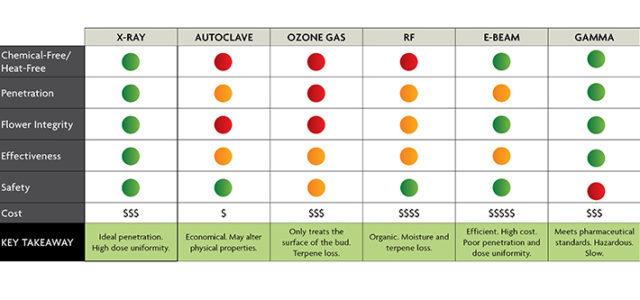Navigating Your Options to Achieve Clean Cannabis
Marijuana Industry News February 6, 2023 MJ Shareholders 0

Improving Your Post-Harvest Remediation Strategy is The Best Way to Ensure Product Passes Microbial Testing
Dangers of Microbial Growth:
Cannabis operations of all sizes risk exposure to biological contaminants, like mold, yeast, aspergillus, E. Coli, Salmonella, and other harmful pathogens.
Most states with legalized cannabis have enacted legislation requiring all products destined for distribution to pass various microbial tests before releasing their product to the market. Shockingly, 10-15% of legal cannabis flower tests over state CFU (Colony Forming Unit) limits.
Failed microbial testing can cost millions in lost revenue for commercial cannabis growers, with ramifications ranging from required product disposal, costly fines, liability litigation, reputation damage, and even the loss of the business license.
As the cannabis industry matures, we will likely see regulations evolve into more uniform standards with even more stringent limits for testing to ensure the safety of cannabis consumers, both medical and recreational.
Consumer Demand for Safe, Clean Cannabis
Several recent news stories have covered incidents of cannabis brands recalling products due to microbial contamination, which may lead to serious health issues, including respiratory problems, allergic reactions, and other life-threatening problems.
A significant segment of consumers use cannabis for medical purposes. In California, for example, it is estimated that around 80-90% of cannabis users hold a medical marijuana card – and consumers with auto-immune disorders and pre-existing conditions are especially at risk for complications when exposed to contaminated cannabis.
In addition to increasing governmental regulations and testing, consumers want to know they can purchase safe, clean cannabis products. A new study has found that many Americans would be willing to pay more for products they know they can trust. Two-thirds of Americans (67%) say if they were to purchase cannabis, they would pay more for cannabis products if they had a secure label that designated them as being from a licensed provider that adheres to safety and legal standards.
By knowing their cannabis has been grown and processed according to good manufacturing practices (GMP), consumers can have peace of mind that the products they are purchasing are safe to consume and are free of chemicals and pathogens. Additionally, consumers want to feel trust in the companies that make the brands they love. Knowing that those brands are committed to the quality of their products and their customers’ safety gives buyers a great reason to support and advocate for the legal cannabis industry – rather than purchasing black market products.
The cannabis consumers have spoken, and it’s clear that clean cannabis and GMPs are critical for the success and reputation of brands and products in the legal cannabis industry.
Pre-Harvest Methods Are No longer Sufficient
Traditionally, cannabis cultivators have focused their risk management strategy for microbial growth on the pre-harvest/grow phase of cultivation. Countless hours and resources are spent to ensure the growing process is safe from contamination using HVAC systems, light control, pesticides, testing, etc.
Unfortunately, even using the most sophisticated clean-room grow methods, there are numerous pre- and post-harvest opportunities for contamination. For example, any time flower is handled in post-processing is an opportunity for contamination, and it’s impossible to ensure 100% proper handling and storage conditions at every step from seed to sale.
While smaller farms can usually manage the growth environment to mitigate the risk of contamination more efficiently, the situation changes for commercial, large-scale growers, where contamination is highly likely.
Post-Harvest Cannabis Decontamination
When cannabis samples fail lab testing, and there is a detectable bioburden above the legal threshold, there are only two ways to salvage a crop: extraction or remediation.
Some manufacturers choose to sell flower wholesale for extraction into concentrate. The extraction process (with solvents) will rid the product of microbial contaminants. The cannabis products can then be distributed and sold to consumers. Although extraction is a reliable method, it hurts the manufacturer’s bottom line because high-grade flower almost always sells at a higher wholesale price than flower used in extraction.
Remediation of cannabis is defined as reducing contaminant levels below the acceptable legal threshold. Post-harvest remediation aims to decontaminate or kill harmful bacteria that may have been present on the plants during the growing process or that may have developed during the harvest or packaging process.
While remediation of cannabis has been a mainly reactive approach, forward-thinking producers are starting to decontaminate their cannabis products before initial testing, saving valuable time and money and creating a more stable supply chain.
Remediation Methods: Understanding Your Options
Cultivators must ensure solid post-harvest remediation strategies are in place and up-to-date to produce safe, high-quality cannabis products free from harmful contaminants.
Depending on the decontamination method, post-harvest remediation can be less expensive, less labor intensive, and more effective in ensuring safe, clean cannabis.
While there is a potential initial investment in decontamination equipment and in developing a new internal process, the long-term cost savings, convenience, and peace of mind can be worth it for both small and large-scale cultivators to explore.
When choosing the best post-harvest remediation method for their business, there are several factors cultivators should consider:
- Effectiveness in eliminating contaminants to ensure product passes regulatory tests
- Impact on the quality or integrity of the final product
- Ease of implementing the method into existing cultivation facility processes, including floor plan requirements and operation training
- Processing times and quantities
- Safety of the process for employees and consumers
- How long (if ever) it takes for the ROI to balance out the investment, taking into account potential ongoing and maintenance costs
There are many different decontamination methods available using various technologies that have crossed over from the food industry, but not all are ideal for the unique requirements of cannabis.
Leading post-harvest cannabis remediation methods include: Solvents such as ethanol or CO2, Autoclave, Ozone Gas, Radio Frequency (RF), Ebeam, Gamma, and X-ray. Each method can vary significantly in effectiveness, cost, safety, quality, and other vital factors. It benefits cultivators, wholesale distributors, and other key stakeholders concerned with compliance and quality to be well informed of their options for cannabis decontamination and knowledgeable in the science behind them before investing in new equipment.
Each method can vary significantly in effectiveness, cost, safety, quality, and other vital factors. It benefits cultivators, wholesale distributors, and other key stakeholders concerned with compliance and quality to be well informed of their options for cannabis decontamination and knowledgeable in the science behind them before investing in new equipment.
While there are many remediation options to choose from, if used at all, the decision remains dependent on each company’s priorities.
For cannabis companies that prioritize consumer safety, it is imperative to consider a proactive approach to remediation. Remediation is a sound strategy to ensure cannabis products will pass any existing and future microbial testing requirements, and cannabis companies can have complete confidence that they are only distributing safe, clean cannabis into the legal marketplace.
Post-harvest remediation can and should play a critical role in cannabis processing operations. By taking a proactive approach to remediation, cannabis companies can mitigate financial risk and ensure the health and well-being of their customers, thus enabling their brands to thrive.
MJ Shareholders
MJShareholders.com is the largest dedicated financial network and leading corporate communications firm serving the legal cannabis industry. Our network aims to connect public marijuana companies with these focused cannabis audiences across the US and Canada that are critical for growth: Short and long term cannabis investors Active funding sources Mainstream media Business leaders Cannabis consumers









No comments so far.
Be first to leave comment below.